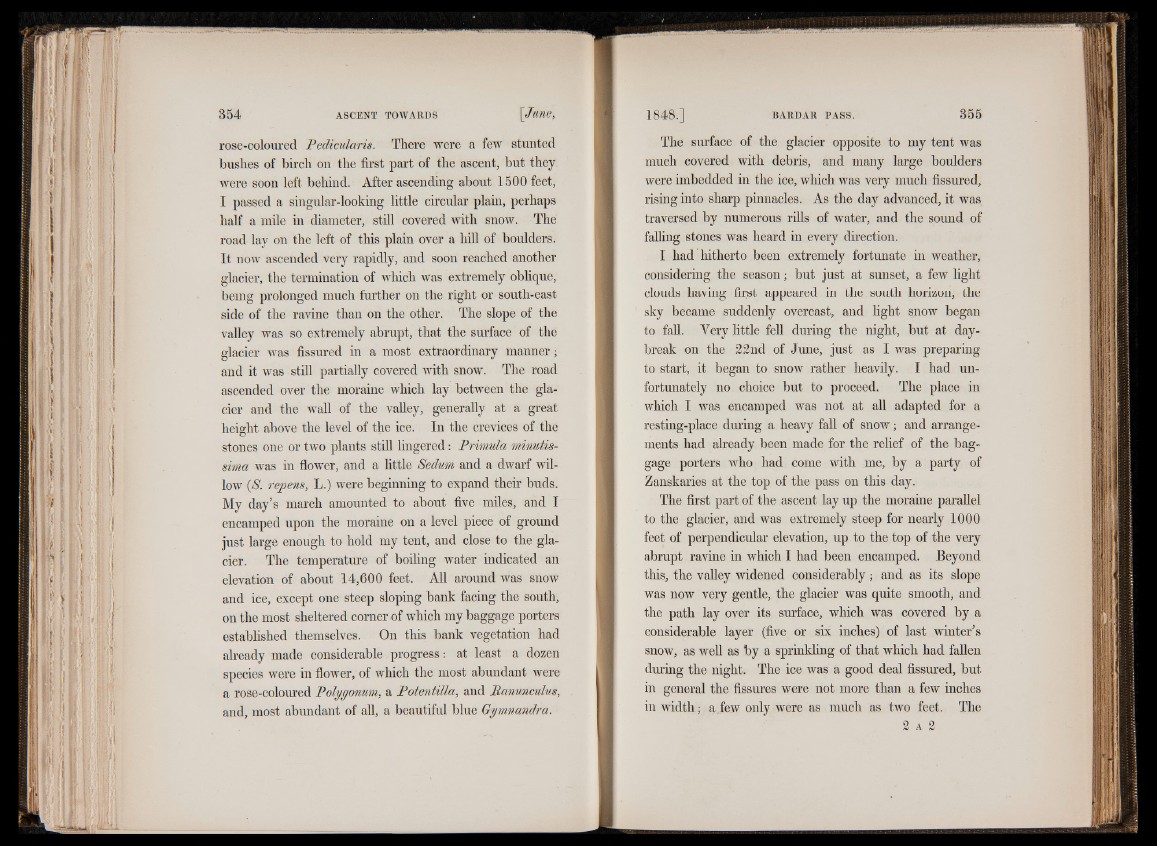
rose-coloured Pedicularis. There were a few stunted
bushes of birch on the first part of the ascent, but they,
were soon left behind. After ascending about 1500 feet,
I passed a singular-looking little circular plain, perhaps
half a mile in diameter, still covered with snow. The
road lay on the left of this plain over a hill of boulders.
It now ascended very rapidly, and soon reached another
glacier, the termination of which was extremely oblique,
being prolonged much further on the right or south-east
side of the ravine than on the other. The slope of the
valley was so extremely abrupt, that the surface of the
glacier was fissured in a most extraordinary manner;
and it was still partially covered with snow. The road
ascended over the moraine which lay between the glacier
and the wall of the valley, generally at a great
height above the level of the ice. o In the crevices of the
stones one or two plants still lingered: Primula minutis-
sima was in flower, and a little Sedum and a dwarf willow
{8. repens, L.) were beginning to expand their buds.
My day’s march amounted to about five miles, and I
encamped upon the moraine on a level piece of ground
just large enough to hold my tent, and close to the glacier.
The temperature of boiling water indicated an
elevation of about 14,600 feet. All around was snow
and ice, except one steep sloping bank facing the south,
on the most sheltered corner of which my baggage porters
established themselves. On this bank vegetation had
already made considerable progress -. at least a dozen
species were in flower, of which the most abundant were
a rose-coloured Polygonum, a Potentilla, and Ranunculus,
and, most abundant of all, a beautiful blue Gymnandra.
The surface of the glacier opposite to my tent was
much covered with debris, and many large boulders
were imbedded in the ice, which was very much fissured,
rising into sharp pinnacles. As the day advanced, it was
traversed by numerous rills of water, and the sound of
falling stones was heard in every direction.
I had hitherto been extremely fortunate in weather,
considering the season; but just at sunset, a few light
clouds having first appeared in the south horizon, the
sky became suddenly overcast, and light snow began
to fall. Very little fell during the night, but at daybreak
on the 22nd of June, just as I was preparing
to start, it began to snow rather heavily. I had unfortunately
no choice but to proceed. The place in
which I was encamped was not at all adapted for a
resting-place during a heavy fall of snow; and arrangements
had already been made for the relief of the baggage
porters who had come with me, by a party of
Zanskaries at the top of the pass on this day.
The first part of the ascent lay up the moraine parallel
to the glacier, and was extremely steep for nearly 1000
feet of perpendicular elevation, up to the top of the very
abrupt ravine in which I had been encamped. Beyond
this, the valley widened considerably; and as its slope
was now very gentle, the glacier was quite smooth, and
the path lay over its surface, which was covered by a
considerable layer (five or six inches) of last winter’s
snow, as well as by a sprinkling of that which had fallen
during the night. The ice was a good deal fissured, but
in general the fissures were not more than a few inches
in width; a .few only were as much as two feet. The
2 a 2